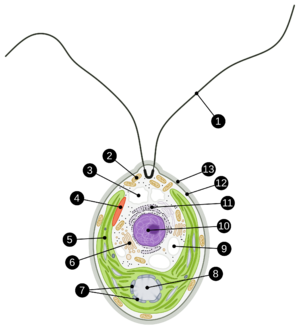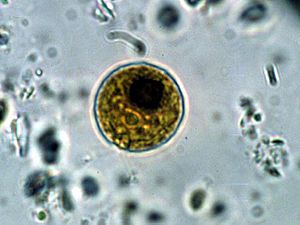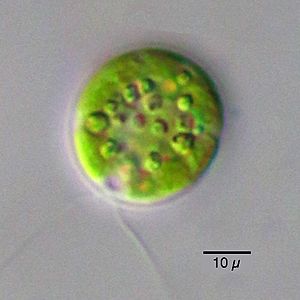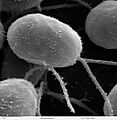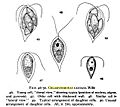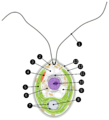Chlamydomonas facts for kids
Quick facts for kids Chlamydomonas |
|
|---|---|
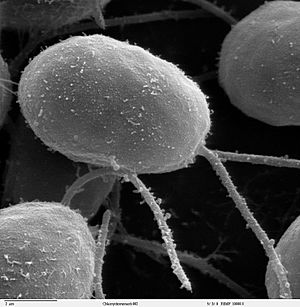 |
|
| SEM image of flagellated Chlamydomonas (10000×) | |
| Scientific classification |
|
| Phylum: | Chlorophyta |
| Class: | Chlorophyceae |
| Order: | Chlamydomonadales |
| Family: | Chlamydomonadaceae |
| Genus: | Chlamydomonas Ehrenb. |
| Species | |
|
See text |
|
Chlamydomonas is a type of tiny green algae. These organisms are so small you need a microscope to see them! They are single-celled and have two whip-like tails called flagella. You can find them in many places, like still water, wet soil, fresh water, sea water, and even in snow. When they live in snow, they are sometimes called "snow algae."
Scientists often use Chlamydomonas as a model organism. This means they study it to learn more about how cells work. They are especially useful for understanding how flagella move and how chloroplasts (the parts of a plant cell that make food from sunlight) grow and work. One cool thing about Chlamydomonas is that it has special parts called ion channels that can be turned on directly by light.
Scientists have learned that the traditional way of grouping Chlamydomonas species by how they look isn't always accurate. Because of this, many species have been moved to different groups.
Contents
What is Chlamydomonas?
These tiny organisms are usually round or a bit like a cylinder. They might have a small bump on one end. Inside, they have a green part called a chloroplast, which is often shaped like a cup. This is where they make their food using sunlight. A key feature is their two long, whip-like tails called flagella. These tails help them swim.
Where Does Chlamydomonas Live?
Chlamydomonas lives in many places, like fresh water or wet soil. They often like places with lots of certain nutrients. They have a tiny red 'eye spot' that helps them sense light. This spot tells them where the light is so they can move towards it.
How Does Chlamydomonas Reproduce?
Chlamydomonas can make copies of themselves in two main ways:
- Asexual reproduction: This means they can create new cells all by themselves, without needing another cell. They can do this by simply splitting into new cells.
- Sexual reproduction: This involves two Chlamydomonas cells joining together to create a new cell.
How Does Chlamydomonas Get Food?
Most Chlamydomonas species get their energy from sunlight, just like plants. This process is called photosynthesis. But some types, like C. reinhardtii, can also eat other things. If there's no light, they can grow by using a chemical called acetate as food.
What Does Chlamydomonas Look Like Up Close?
- They are tiny, single-celled algae that can move.
- They are usually oval-shaped.
- Their outer wall is made of special proteins and sugars, not the same material as plant cell walls.
- They have two whip-like tails (flagella) at the front. Each tail starts from a small base inside the cell. These tails have a special structure with many tiny fibers arranged in a '9+2' pattern.
- They have small parts called contractile vacuoles near the base of their tails. These help pump out extra water.
- A large, cup-shaped chloroplast is present. This chloroplast contains flat sacs called thylakoids, which are where photosynthesis happens.
- The cell's control center, the nucleus, is inside the cup-shaped chloroplast. The chloroplast also has a large pyrenoid, which is where starch (their stored food) is made from photosynthesis.
- They have an eye spot in the front part of the chloroplast. It's made of tiny fat droplets arranged in rows, helping them detect light.
Types of Chlamydomonas
Here are some of the many different species of Chlamydomonas:
- Chlamydomonas acidophila
- Chlamydomonas caudata Wille
- Chlamydomonas ehrenbergii Gorozhankin
- Chlamydomonas elegans G.S.West 1915
- Chlamydomonas moewusii
- Chlamydomonas nivalis
- Chlamydomonas ovoidae
- Chlamydomonas reinhardtii
See also
 In Spanish: Chlamydomonas para niños
In Spanish: Chlamydomonas para niños
Images for kids
-
SEM image of flagellated Chlamydomonas (10000×)



